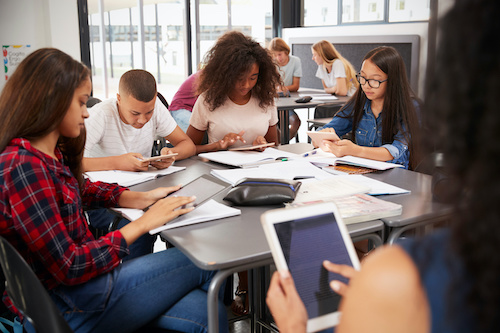Key points:
- Stay up to date on the latest trends about learning in the digital age
After decades of working with educational technology, I’ve come to the realization that technology will have its greatest impact in the classroom when educators allow learners to use digital technology as a self-directed learning tool. This means not just providing students with laptops and online resources, but ensuring they have the necessary skills to find, validate, apply, and curate the vast amount of information now available to them.
More importantly, they must be given control of when and how these digital tools are used. Think about how adults use their smartphones; they use them whenever they need to. No one is dictating when they can use it, how they can use it, or where they can use it–why don’t we allow learners to do the same?
Imagine a classroom where students have unfettered access to digital tools and resources whenever needed. That would be a very different classroom than the ones I’ve experienced, but one that would be able to support the digital learners in our classrooms today.
This realization is based on years of implementing various educational technology initiatives, and the recognition of the similarity between the impact mechanical technology had on the Industrial Age and how digital technology has impacted the Information Age. When mechanized technology was introduced, it was primarily used to replace repetitive and rote physical tasks. It took a while for people to be comfortable with mechanized automation, but once they were, it created growth and advances in manufacturing that were previously unattainable.
Similarly, today’s digital tools can be used to replace repetitive and rote mental tasks. In other words, digital technology has automated memorization. In a typical classroom, students learn content through processes that rely heavily on a variety of rote and repetitive activities. These activities not only help students learn the content, but also allow them to develop memorization skills.
Traditional learning emphasizes knowledge retention and the skill of memorization. But the technology of today can be used as a tool to unburden the learner’s mind from rote tasks like memorization. From a learning perspective, the automation of memorization will empower today’s students to use information to develop learning skills such as analyzing, synthesizing, evaluating, and creating instead of just memorizing information. These skills will not only prepare students to learn and work in the Information Age, but will give them access to more knowledge than through traditional instruction
Teachers can use the automation of memorization to help shift the focus of instruction from knowledge retention to knowledge application. This shift will expand the development of the learner’s higher-order learning skills. Instruction that is problem- or project-based, learner -entered, and emphasizes higher-order skill development over content retention is what today’s students need. This type of instruction will give learners experiences that will emphasize knowledge construction, identifying and solving problems, and being creative and collaborative.
Fortunately, the learner-centered instructional strategies needed to support these changes are not new to teachers. As student proficiency in these new digital skills grows, lessons can become more problem/project-based to allow students to take advantage of their newly-learned skills. The time that was spent delivering content can now be allocated to completing projects that develop and strengthen higher-order learning skills. A shift to learning by doing, not memorization, will better prepare learners for the information-rich world they live in.
Giving students the power to access digital tools on demand will require a shift in how teachers design instruction. This will impact curricular decisions, assessment design, and the selection of resources. For centuries, success at school has been defined by students learning their facts, but now that students have unfettered access to information and resources, educators need to reconsider what learning means. Because memorization has been automated, memorizing should be de-emphasized so that students can focus on the higher-order skills needed to navigate the Information Age.
Recent public opinion polls have shown that the spread of misinformation is a growing concern for many. Given that many social media sites influence what information users see, it is not surprising that the public is concerned about misinformation. Without an understanding of how to manage and question information presented to them, users could be more likely to blindly accept it without question. Students need skills to validate information presented to them, to find other relevant information, and to apply the information to ensure they are getting all of the facts.
Teaching learners these skills while they are in school will provide a means for addressing the information overload they will experience as adults. Then, they can leverage their growing access to information to open doors to new ideas and different perspectives instead of unquestionably accepting the information forced upon them.
Public Affairs and Media Research. (2022, October 13). Many believe misinformation is increasing extreme political views and behaviors. AP-NORC. https://apnorc.org/projects/many-believe-misinformation-is-increasing-extreme-political-views-and-behaviors/
ISTE standards: Students. ISTE. (n.d.). Retrieved January 10, 2023, from https://www.iste.org/standards/iste-standards-for-students
Higher order thinking: Bloom’s taxonomy. Learning Center. (2022, June 6). Retrieved January 10, 2023, from https://learningcenter.unc.edu/tips-and-tools/higher-order-thinking/
Related:
5 innovative ways educators are using digital learning tools
ChatGPT can generate, but can it create?
- 4 ways to encourage play in education - April 25, 2024
- It’s time to pay student teachers - April 25, 2024
- The evolving requirements of a K-12 school network - April 24, 2024

